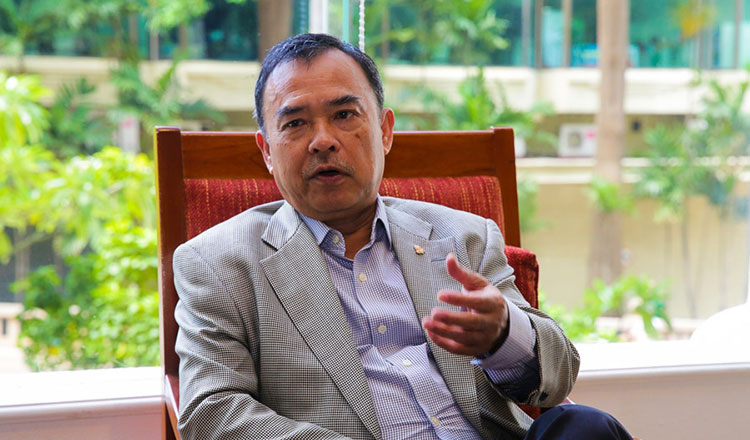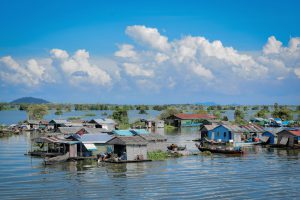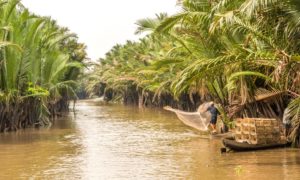Previously secretary of state at the Foreign Affairs Ministry for the Cambodian government, Pou Sothirak is executive director of the Cambodian Institute for Cooperation and Peace. He is a tireless campaigner for the ecology and communities of the Lower Mekong and particularly Tonle Sap, Southeast Asia’s largest lake and one of the most productive inland fisheries on the planet. Pou Sothirak spoke with The Third Pole about the future of Cambodia on the dammed Mekong.
Tonle Sap has been drastically affected by the changing Mekong. However, the Mekong River Commission (MRC), an entirely advisory body, has offered seemingly no resistance to large dam projects. How can downstream countries protect against further developments?

Although the MRC has been relatively successful at generating knowledge and developing a set of useful rules and guidelines to promote the reasonable and equitable use of the Mekong River system, when it comes to large dam projects, the MRC has little or no success in finding consensus on important decisions. Member states prefer to “agree to disagree” when it comes to prior consultations on dams, such as the Xayaburi and Don Sahong dams in Laos.
The MRC risks becoming irrelevant if member states fail to enforce their political will and ensure that the 1995 Mekong Agreement is implemented in a responsible manner. Ways must be found to strengthen the role of the MRC in order to safeguard the Mekong.
Last year, the Cambodian government put a 10-year moratorium on Mekong mainstream dam building, including the Sambor dam from China’s HydroLancang International and Cambodia’s well-connected Royal Group. It is the closest of the mainstream dams to Tonle Sap. Obviously, this is a win for Tonle Sap, but Cambodia’s power needs keep growing. How can conservationists stop Sambor in 2030?
The announcement should be treated as a welcome sign. I think the government is mindful of the spin-off consequences created by hydropower plants. The negative effects are real and dreadful, altering the natural pulse of the Mekong River and Tonle Sap Lake, depleting fish stocks, creating drought, harming the biodiversity of the Mekong, and putting an enormous strain on the lives of many of Cambodia’s most vulnerable groups.
Solar energy represents a viable prospect for meeting energy demand in Cambodia and diversifies renewable power. For a nation that counts on large dams, fossil fuels and coal power to meet increased energy demand, solar energy in Cambodia has potential to be a significant step toward a lower-carbon electricity grid.
Solar is a renewable energy that allows Cambodia to opt away from controversial hydropower that could adversely affect the Mekong River and it reduces Cambodia’s dependence on fossil fuel-generated power. From scepticism in 2016, Cambodia now plans to generate 20% of its power from solar within the next few years, up from just 1% in 2018. And by 2020 the Cambodian government estimated that 15% of all energy produced in the kingdom would come from solar panels.
There are promising signs that Cambodia will turn to solar when it comes to meeting the energy demands of the future. This is a positive development that must be pursued to reduce the reliance on controversial hydropower plants. It would be a brave decision for Cambodia to cancel the Sambor dam altogether.
Solar is a renewable energy that allows Cambodia to opt away from controversial hydropower that could adversely affect the Mekong RiverPou Sothirak
Tonle Sap has suffered from continuously declining fish stocks and unpredictable levels. This year, China has made more data available than ever before; has this been of much value to conservation efforts?
Tonle Sap’s ‘flood pulse’ is severely affected by climate conditions and numerous man-made disasters – lack of water governance, dams, deforestation of Cambodia’s lowland forests ecosystems. Any conservation efforts are much welcome to safeguard this great lake, a world heritage ecological reserve heading toward a tipping point.
During the third Mekong-Lancang Cooperation Leaders’ Meeting held on 24 August 2020 via teleconference, hopeful signs emerged to enhance cooperation between the MRC Secretariat and the China-led Mekong-Lancang Water Resources Cooperation Center to work out a suitable arrangement for a data-sharing scheme.
Whether China intends to set up a separate data-sharing mechanism or whether it would work with the MRC remains an open question. Both China and the MRC need to work out the details and uphold the momentum that has been built thus far in accordance with the spirit of the 2019 MOU.
North of Cambodia’s border, there are seven Mekong dams in various stages of planning and completion, most with some level of Chinese investment. How can downstream nations better engage with Lancang-Mekong Cooperation (LMC) mechanism to support protection of the Mekong’s ecology?

As the LMC takes centre stage in the development of mainland Southeast Asia, there are myriad opportunities for productive collaboration between China and the mainland ASEAN states and other stakeholders. But there are also challenges to overcome in order for LMC projects to be seen as supportive to sustainable and inclusive development.
For the lower Mekong countries, while all five countries have expressed support for the China-led LMC, Myanmar, Thailand and Vietnam are more cautious of China’s strategic intentions compared to Cambodia and Laos, which are relatively comfortable and confident in accepting China’s geoeconomic presence. Cambodia is the most enthusiastic for China-led multilateral mechanisms, such as the BRI [Belt and Road Initiative] and LMC.
For China, the Mekong region represents abundant potential growth and a strategic playground amidst unfolding geopolitical shifts. The LMC is a strategic initiative that would allow Beijing to bolster China’s influence in the Mekong region. By design, China aspires to uphold the LMC as the spirit of openness and inclusiveness and states that its ‘modus operandi’ is compatible with and complementary to other sub-regional cooperation frameworks.
However, challenges remain stern, particularly in the absence of an effective mechanism to oversee monitoring and evaluation of the project. Without this, the LMC is poised to face strong headwinds as other powers in the region and beyond are competing to exert their Mekong basin policies as well.
If China is to be viewed as a responsible regional power, Beijing will have to make certain that all projects under the LMC framework are properly, usefully and fairly implemented. This way, the LMC will reinforce the spirit of cooperation among the six countries along the Mekong and serve as a concrete road map in the future to energise the LMC initiative, allowing all the people of CLMV (Cambodia, Laos, Myanmar and Vietnam) and Thailand to reap greater benefits.








